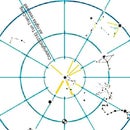Introduction: Finding North With a Watch More Accurately P2
by tonytran2015 (Melbourne, Australia)
This is the second part (for Southern hemisphere) of a method that uses a common 12-hour watch with analogue face for finding directions. Unlike the traditional method of using the hour hand of a flat lying watch, my method uses a watch tilted from the vertical and gives better accuracy for both North and South hemispheres including tropical zones. When applied to the arctic and antarctic regions, the watch is tilted by more than 67 degrees and lies almost flat on the ground; it becomes the traditional method using flat lying watch.
This method uses the position of the Sun, time and known latitude angle to determine directions and Sun declination (therefore estimation of current month of the year).
Step 1:
Method for Southern latitudes.
The word “reflected-bisector” here is used to mean the bisector of the angle between the midnight/midday marking and the hour hand of a counter-clockwise watch which is the mirror reflection of a normal watch. Since it is not practical to obtain such a watch, an observer must imagine one from the (left to right) reflection of his normal watch.
1/- Hold the watch so that its AXIS rises above the horizontal plane by an angle equal to the latitude of the region. That is its face points to somewhere in the sky and its back is angled downwards into the ground.
2S/- Determine the half-plane limited by the axis of the watch and containing the reflected-bisector. This half plane revolves anti-clockwise about the axis of the watch once every 24 hour and goes through the mid-day marking at noon.
Step 2:
This picture uses an imaginary mirror-reflection watch ; the positions of 3 and 9 o"clock on its dial are opposite to those of a normal watch and its hands go counter-clockwise (I named it Reflection and it is showing a time of 08h:11:50.). The red line is the reflected-bisector. It is the bisector of the mirror-reflection watch. The line CB is drawn on a card representing the half-plane to enable accurate alignment to the Sun. Note that the reflected-bisector is always the mirror reflection of the bisector in the normal watch named Northern.
Step 3:
3S/- Determine on the semi-plane a half-line CB from the center C of the watch dial, forming with the watch axis an angle equal to the angle between the direction to the Sun and the Celestial axis. The half-line CB starts from the center of the dial and is nearly in the direction of the reflected-bisector. It rises above the dial toward the glass and points through the glass of the watch during local summer time and dives below the dial into the movement compartment of the watch and points through the movement of the watch during winter time. This half-line always points to the Sun if this watch displays the local time and the face of the watch and its axis point to the South Celestial pole.
Step 4:
Figure 1: Summary of the finding North by a watch.
4S/- Hold the watch in such composure and rotate your whole body around your vertical axis by your feet until the Sun lies in the above half-plane, which is denoted by the cyan flag in the following photo. Instead of trying to have the half-plane containing the Sun, observer can try to point the half-line CB towards the Sun. This gives better accuracy.
Step 5:
Figure 1: Summary of the finding North by a watch. Red hand is the bisector of 0 hr direction and the hour hand; green hand is its reflection across the (6-12) axis. Axis C-BS for Southern hemisphere is parallel to green hand at equinox days and is (raised above)/(dipped below) the watch dial by 23 degrees at local summer/winter solstice. Green drawing marks are for Southern hemisphere and are the mirror reflection of red drawing marks.
5S/- At that position, the watch face and its AXIS are POINTING to the Southern Celestial pole. Tilt the watch further, until it lies horizontally. In this horizontal position, the mid-day marking is pointing North and the 6 o’clock marking is pointing South.











